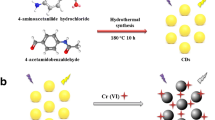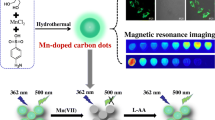Abstract
Yellow-emissive carbon dots (Y-CDs) were prepared by a solvothermal method using anhydrous citric acid and 2,3-phenazinediamine as the starting materials. The Y-CDs display a 24% fluorescence quantum yield, a 188-nm Stokes’ shift and excellent stability. They are shown here to be excellent fluorescent probes for the determination of Ag(I) ion and glutathione (GSH). If exposed to Ag(I) ions, they are bound by the carboxy groups of the Y-CDs, and this causes quenching of fluorescence (with excitation/emission maxima at 380/568 nm) via a static quenching mechanism. This effect was used to design a fluorometric assay for Ag(I). The quenched fluorescence of the Y-CDs can be restored by adding GSH due to the high affinity of GSH for Ag(I). The calibration plot for Ag(I) is linear in the 1–4 μM Ag(I) concentration range, and the limit of detection is 31 nM. The respective values for GSH are 5–32 μM, and 76 nM, respectively. The method was applied to the detection of Ag(I) in spiked environmental water samples and gave recoveries ranging from 93 to 107%. It was also applied to the determination of GSH in tomatoes and purple grapes and gave satisfactory recoveries. The Y-CDs display low cytotoxicity and were successfully used to image Ag(I) and GSH in H1299 cells.

Schematic presentation of the mechanism of yellow fluorescent CDs for the detection of Ag+ and glutathione.










Similar content being viewed by others
References
Wang F, Lu Y, Chen Y, Sun J, Liu Y (2018) Colorimetric Nanosensor based on the aggregation of AuNP triggered by carbon quantum dots for detection of Ag+ Ions. ACS Sustain Chem Eng 6:3706–3713
Yan F, Kong D, Luo Y, Ye Q, He J, Guo X, Chen L (2016) Carbon dots serve as an effective probe for the quantitative determination and for intracellular imaging of mercury(II). Microchim Acta 183(5):1611–1618
Wu D, Li G, Chen X, Qiu N, Shi X, Chen G (2017) Fluorometric determination and imaging of glutathione based on a thiol-triggered inner filter effect on the fluorescence of carbon dots. Microchim Acta 184:1923–1931
Wang Q, Pang H, Dong Y, Chi Y, Fu F (2018) Colorimetric determination of glutathione by using a nanohybrid composed of manganese dioxide and carbon dots. Microchim Acta 185(6):291–298
Guo Y, Yang L, Li W, Wang X, Shang Y (2016) Carbon dots doped with nitrogen and sulfur and loaded with copper(II) as a “turn-on” fluorescent probe for cystein, glutathione and homocysteine. Microchim Acta 183:1409–1416
Yan F, Ye Q, Xu J, He J, Chen L, Zhou X (2017) Carbon dots-bromoacetyl bromide conjugates as fluorescence probe for the detection of glutathione over cysteine and homocysteine. Sensors Actuators B Chem 251:753–762
Juan H, Wang W, Zhou T, Wang B, Li H, Ding L (2016) Synthesis and formation mechanistic investigation of nitrogen-doped carbon dots with high quantum yields and yellowish-green fluorescence. Nanoscale 8:11185–11193
Song Z, Dai X, Li M, Teng H, Song Z, Xie D (2018) Biodegradable nanoprobe based on MnO2 nanoflowers and graphene quantum dots for near infrared fluorescence imaging of glutathione in living cells. Microchim Acta. https://doi.org/10.1007/s00604-018-3024-y
Gao W, Song H, Wang X, Liu X, Pang X, Zhou Y (2018) Carbon dots with red emission for sensing of Pt2+, Au3+, and Pd2+ and their bioapplications in vitro and in vivo. ACS Appl Mater Interfaces 10:1147–1154
Shao J, Zhu S, Liu H, Song Y, Tao S, Yang B (2017) Full-color emission polymer carbon dots with quench-resistant solid-state fluorescence. Adv Sci (Weinh) 4:1700395–17003103
Jiang K, Sun S, Zhang L, Wang Y, Cai C, Lin H (2015) Bright-yellow-emissive N-doped carbon dots: preparation, cellular imaging, and bifunctional sensing. ACS Appl Mater Interfaces 7:23231–23238
Shi L, Li L, Li X, Zhang G, Zhang Y, Dong C, Shuang S (2017) Excitation-independent yellow-fluorescent nitrogen-doped carbon nanodots for biological imaging and paper-based sensing. Sensors Actuators B Chem 251:234–241
Yuan F, Wang Z, Li X, Li Y, Tan Z, Fan L, Yang S (2017) Bright multicolor bandgap fluorescent carbon quantum dots for electroluminescent light-emitting diodes. Adv Mater 29:1604436–1604442
Jiang K, Sun S, Zhang L, Wang Y, Cai C, Lin H (2015) Red, green, and blue luminescence by carbon dots: full-color emission tuning and multicolor cellular imaging. Angew Chem Int Ed 54:5360–5363
Niu F, Xu Y, Liu M, Sun J, Guo P, Liu J (2016) Bottom-up electrochemical preparation of solid-state carbon nanodots directly from nitriles/ionic liquids using carbon-free electrodes and the applications in specific ferric ion detection and cell imaging. Nanoscale 8:5470–5477
Liu Y, Li J, Wang M, Li Z, Liu H, He P, Yang X, Li J (2005) Preparation and properties of nanostructure Anatase TiO2 monoliths using 1-Butyl-3-methylimidazolium Tetrafluoroborate room-temperature ionic liquids as template solvents. Cryst Growth Des 5:1643–1649
Yuan L, Niu Y, Li R, Zheng L, Wang Y, Liu M, Xu G, Huang L, Xu Y (2018) Molybdenum oxide quantum dots prepared via a one-step stirring strategy and their application as fluorescent probes for pyrophosphate sensing and efficient antibacterial materials. J Mater Chem B 6:3240–3245
Xu G, Niu Y, Yang X, Jin Z, Wang Y, Xu Y, Niu H (2018) Preparation of Ti3C2Tx MXene-derived quantum dots with white/blue-emitting photoluminescence and Electrochemiluminescence. Adv Optical Mater 6:1800951–1800960
Xu G, Wang X, Gong S, Wei S, Liu J, Xu Y (2018) Solvent-regulated preparation of well-intercalated Ti3C2Tx MXene nanosheets and application for highly effective electromagnetic wave absorption. Nanotechnology 29:355201. https://doi.org/10.1088/1361-6528/aac8f6
Jin Z, Fang Y, Wang X, Xu G, Liu M, Wei S, Zhou C, Zhang Y, Xu Y (2018) Ultra-efficient electromagnetic wave absorption with ethanol-thermally treated two-dimensional Nb2CTx nanosheets. J Colloid Interface Sci 537:306–315
Ding H, Yu S, Wei J, Xiong H (2016) Full-color light-emitting carbon dots with a surface-state-controlled luminescence mechanism. ACS Nano 10:484–491
Ye Q, Yan F, Kong D, Zhang J, Zhou X, Xu J (2017) Constructing a fluorescent probe for specific detection of catechol based on 4-carboxyphenylboronic acid-functionalized carbon dots. Sensors Actuators B Chem 250:712–720
Borse V, Thakur M, Sengupta S, Srivastava R (2017) N-doped multi-fluorescent carbon dots for ‘turn off-on’ silver-biothiol dual sensing and mammalian cell imaging application. Sensors Actuators B Chem 248:481–492
Cai Q, Li J, Ge J, Zhang L, Hu Y, Li Z (2015) A rapid fluorescence "switch-on" assay for glutathione detection by using carbon dots-MnO2 nanocomposites. Biosens Bioelectron 72:31–36
Zu F, Yan F, Bai Z, Xu J, Wang Y, Huang Y (2017) The quenching of the fluorescence of carbon dots: a review on mechanisms and applications. Microchim Acta 184:1899–1914
Wang F, Hao Q, Zhang Y, Xu Y, Lei W (2016) Fluorescence quenchometric method for determination of ferric ion using boron-doped carbon dots. Microchim Acta 183:273–279
Gauthler T, Shane E, Guerln W, Seltz W, Grant C (1986) Fluorescence quenching method for determining equilibrium constants for polycyclic aromatic hydrocarbons binding to dissolved humic materials. Environ Sci Technol 20:1162–1166
Patir K, Gogoi S (2017) Facile synthesis of photoluminescent graphitic carbon nitride quantum dots for Hg2+ detection and room temperature phosphorescence. ACS Sustain Chem Eng 6:1732–1743
Mandani S, Sharma B, Dey D, Sarma T (2015) Carbon nanodots as ligand exchange probes in Au@C-dot nanobeacons for fluorescent turn-on detection of biothiols. Nanoscale 7:1802–1808
Ramanan V, Siddaiah B, Raji K, Ramamurthy P (2018) Green synthesis of multifunctionalized, nitrogen-doped, highly fluorescent carbon dots from waste expanded polystyrene and its application in the Fluorimetric detection of Au3+ Ions in aqueous media. ACS Sustain Chem Eng 6:1627–1638
Chen B, Liu M, Zhan L, Li C, Huang C (2018) Terbium(III) modified fluorescent carbon dots for highly selective and sensitive ratiometry of stringent. Anal Chem 90:4003–4009
Liao S, Zhao X, Zhu F, Chen M, Wu Z, Song X (2018) Novel S, N-doped carbon quantum dot-based "off-on" fluorescent sensor for silver ion and cysteine. Talanta 180:300–308
Xu Y, Niu X, Zhang H, Xu L, Zhao S, Chen X, Chen H (2015) Switch-on fluorescence sensing of glutathione in food samples based on a g-CNQDs-Hg2+ chemosensor. J Agric Food Chem 63:1747–1755
Zhao X, Lei C, Gao Y, Gao H, Zhu S, Yang X, You J, Wang H (2017) A ratiometric fluorescent nanosensor for the detection of silver ions using graphene quantum dots. Sensors Actuators B Chem 253:239–246
Acknowledgements
The work described in this manuscript was supported by the National Natural Science Foundation of China (51678409, 51638011 and 51578375), Tianjin Research Program of Application Foundation and Advanced Technology (15ZCZDSF00880), State Key Laboratory of Separation Membranes and Membrane Processes (Z1-201507), and the Program for Innovative Research Team in University of Tianjin (TD13-5042).
Author information
Authors and Affiliations
Corresponding author
Ethics declarations
The author(s) declare that they have no competing interests.
Additional information
Publisher’s Note
Springer Nature remains neutral with regard to jurisdictional claims in published maps and institutional affiliations.
Electronic supplementary material
ESM 1
(DOC 1.39 mb)
Rights and permissions
About this article
Cite this article
Yan, F., Bai, Z., Zu, F. et al. Yellow-emissive carbon dots with a large Stokes shift are viable fluorescent probes for detection and cellular imaging of silver ions and glutathione. Microchim Acta 186, 113 (2019). https://doi.org/10.1007/s00604-018-3221-8
Received:
Accepted:
Published:
DOI: https://doi.org/10.1007/s00604-018-3221-8




